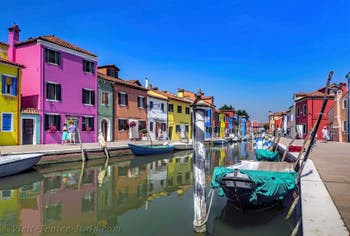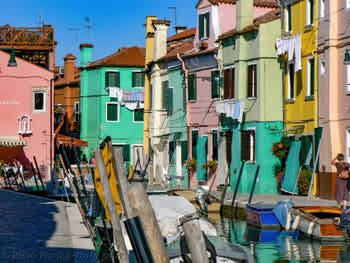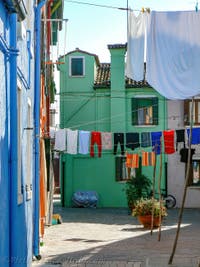Burano Island in Venetian Lagoon, Lace and Colours
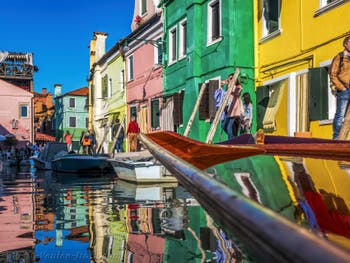
Burano Canal and coloured houses The island of Burano, the island of lace is a small multicoloured gem.
It is a miniature Venice, with its bending bell tower, canals and bridges.
Venice is reproduced in a small model. The houses have an average of one to two floors and the population of Burano, the Buranelli, amounts to five thousand inhabitants.
It is such a special island, with fishermen on one side and lace-maker on the other. Big hands and muscles against tapered and agile fingers.
Burano Island: Lace and Bambini
“A terribly overcrowded small island where women make wonderful lace and men bambini.”
Ernest Hemingway
In Burano, the main fishery today is shellfish fishing.
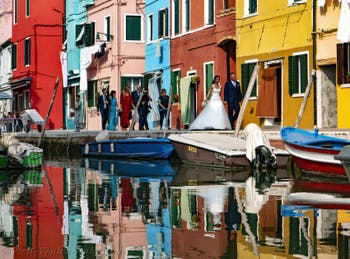
A mariage in Burano Island
“In Burano we find movement and life; this island was once famous for the manufacture of the beautiful laces called points of Venice. [...]
Burano is inhabited by noisy, cheerful mariners living in the open air and seem to wear Austrian yoke more slightly than those of Venice.”
Louise Colet - Italy of Italians 1862
At the end of the 19th century and Austrian occupation, the small island of Burano found itself in total misery, amplified by the almost disappearance of its centuries-old know-how in the manufacture of the famous lace.
Without the opening of a lace school in 1872 to be able to maintain the tradition by teaching it, it is to be feared that no one would be able to realize the laces at the stitch in the air (Punto in aria) that made the world reputation of Burano Island.
With the sewing needle
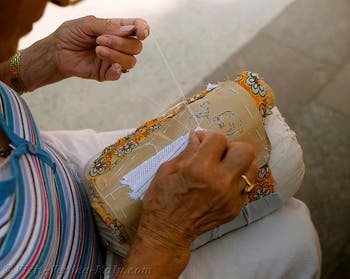
Lace Maker in Burano Island
“On the threshold of low houses, along the canal or on a poor street, we see the lace-pads make their famous point, not with the spindle, but with the sewing needle.
These beautiful hungry women destroy their sight to create fragile adornments, which it is fair to say that they cost the eyes of the head.
Men are fishermen, but the Adriatic is impoverishing fish at the same time as the sale becomes less profitable.”
Maurice Barrès - Amori Dolori Death of Venice 1916
Today, it is lace that makes the island live, although shellfish fishing is also an important element in the income of the Buranelli.
“All blonde and pink, fresh in the light of her big smile that blossomed like an unquenchable source between the pale meanders of Burano's lace.
She had at her side this Andriana Duodo who, on the small industrious island, cultivated a garden of yarn where old-fashioned flowers were marvellously reborn.”
Gabriele d'Annunzio - Fire
The Skilled Lace Makers of Burano Island
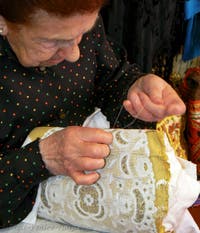
Lace Maker in Burano
“There, the island of Burano, whose wives of the people, simple fishermen, descendants of Arachne, turn the platoons and skeins of yarn into these delicious guipures, which have so much value and reputation.
And since they are pretty beautiful, these simple fishermen, we can address to them this Arabic proverb, a bit exaggerated like all the oriental maxims: The hands of a skilled woman contain ten fairies, housed under ten leaves of roses.”
Noémie Dondel Du Faouëdic - Memories 1875
Of course, as everywhere, Asian lace has also made its appearance in Burano, but if you open your eyes you will very easily know how to distinguish between laces still made by hand and those coming out of industrial looms.
The price is also very different, a piece of genuine Burano lace of 10 cm x 10 cm is at least €100.
A price that is justified because lace at the stitch in the air takes a lot of time.
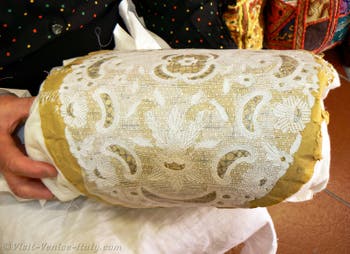
Lace Maker in Burano Island
“Needle lace is done by first throwing a few threads of frames on a drawing stitched or drawn on paper or parchment; these first threads will serve as a support or frame to attach the contours or filling points that will make up the lace to the needle.
The work of these stitches has a lot of analogy with embroidery; it differs from it in that it is not done on a prior background fabric.”
Émile Molinier - Venice Decorative Arts 1889
Many writers described the work of the Burano lacemaker, insisting that they lost sight of it, in short, it was almost inhuman.
Yet if you are lucky enough to meet the Maestra Emma Vidal in Burano like us, you will find that her eyes, which have created the most beautiful lace for decades, are better than yours, that she does not wear glasses and yet she is more than seventy years old.
Burano: Arabesques of fantas
“Burano where the nimble fingers of the lacemakers intertwine the famous arabesques of Venetian fantasy.”
Henri de Régnier - Venetian Stories
Burano: Houses of all colours
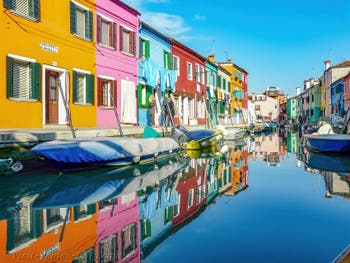
Burano Canal and coloured houses To this tradition of lace that gives its originality to the island, it is necessary to add its multicoloured butterfly beauty.
If the houses are as such any, essentially small fishermen's houses, what makes Burano so attractive is the fact that they are painted in all colours.
It's even a true festival of colours that jumps your eyes when you stroll through the little streets of Burano.
Burano blazes in a fog of gold
“Burano, much larger than Torcello, is still very populated and lively along its many small canals.
Today is festive day.
The fishermen's population, in showy and colourful gala clothes, circulate on narrow quays, in front of the small houses that are bright and clean, whose doors and wide-open windows show the dressers loaded with illuminated coarse earthenware and resplendent repelled copper plates.
Burano Canal and coloured houses Under the sun, it's a fun painting.
Antonio is delighted with our admiration: he also vibrates, but inside, with the cold blood of the phlegmatic gondolier and merely whispers: Per pittori! (for painters)
By showing us with a wide gesture the lively and colourful island that flames in a fog of gold.”
Edmont Radet - Brief Visions 1904
Legend is that Burano's wives painted their houses in bright colours so that their husbands, when they were at sea, could recognize their island from afar.
The colours of the houses changed over time and were certainly not as vivid one or two centuries ago.
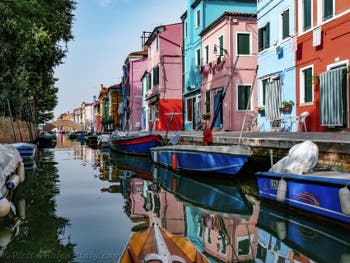
Burano Canal and coloured houses First of all, the choice in colour was more limited, but at that time pigments of minerals and non-organic origin were used.
The main colours were yellow ochre and red ochre. On the other hand, from 1870, appeared the Prussian Blue on the facades of the houses of Burano.
Usually the houses are painted in two to three very contrasting colours.
And today, with modern paints and pigments, we are witnessing a debauchery of colours including the whole range of blues, greens, reds, mauves, etc.
And the miracle of Burano is there: even if sometimes the colours used are daring, harmony is preserved.
Sometimes you feel like walking around a village made of doll houses for children as the colours are young and cheerful.
Add to this that most of these Technicolor facades are reflected in the canals of the city and you get a most original and charming landscape.
Women's Beauty of Burano
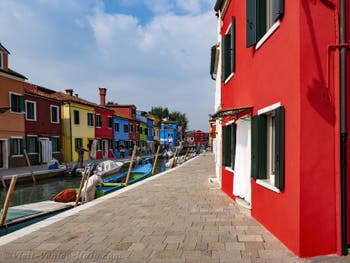
Burano Canal and coloured houses
“From there, the boat returns to Burano where there is a real small town of great character.
Men, all sinners, bare legs, tanned figures, offer more characteristic features than those of the Venetians, and women, simple, living little, locked in their island which preserved them from foreign crossings, have retained all the finesse and purity of their type.
We do not encounter ugly people, so to speak.
They are styled with a red or blue handkerchief that they advance a wide bias fold on the forehead, a hairstyle that still benefits the natural beauty of their face.
The little girls, put in the same way, have lovely figures; some are very brown, others have ashy hair and eyes deep blue.
Burano Canal and coloured houses But these are real wild birds that one should not hope to tame with a smile or a coin of two pennies.
While waiting for them to be large enough to put themselves on lace, they are made to execute small works of pearls.
They are installed in groups in front of the doors, with baskets filled with small beads on the knees, in which they mechanically plunge, without looking, flexible bundles of brass wires on which the beads are strung by hundreds.
They are cheerful like warblers while singing indefinitely the same cantilena, melancholic accent.
The locals are on the doors and look at us "like curious beasts", although this procession is renewed every day during the season.
Burano Coloured Houses We are taken to the workshops where the Burano point is made, as esteemed as that of Venice, but which differs from it in that it has only one side, while the point of Venice is the same on both sides.
It is made of various qualities whose prices range from two francs to two thousand francs per metre, and we are shown fabric of five francs and others of five hundred.
The workers, young, mostly pretty, girded with large white aprons, are gathered in a vast room perfectly clear, airy and remarkably clean.
They have on their knees a large cylindrical cushion on which they make the lace with the needle, not without unscrewing the English visitors who seem to cause their hilarity particularly.
Two young nuns with angelic figures, wearing a curious little black crepe helmet that refines and idealizes their features, impose silence on the laughing with all the seriousness they are capable of, but do not seem to succeed in making themselves feared much.”
Eugène Faugière - Italy Notes and Sketches 1905
Baldassare Galuppi, child of Burano
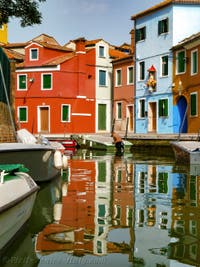
Burano Colourd Houses Burano is also the birthplace of one of Venice's most famous composers in the 18th century, Baldassare Galuppi, nicknamed his entire life "il buranello", the little Burano.
He was renowned far beyond the borders of Venice and conducted the opera for two years at the Haymarket Theatre in London.
But his association with Carlo Goldoni also helped his reputation.
Thus, Carlo Goldoni, librettist and composer Baldassare Galuppi, together produced a number of operas "buffa", operas that earned them many successes at the time and some of which are still played with equally important success today.
Burano, a church a Campanile and a Pope
On the island of Burano, visit the church of San Martino Vescovo, the bell tower that plays with the laws of gravity.The Buranelli to whom we talked about it explained that he has been like this for just over 60 years now.
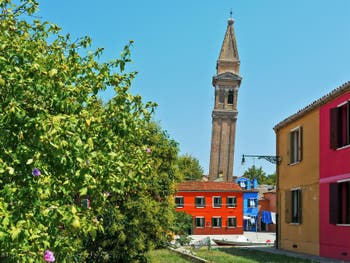
Burano Island Bell Tower At first they were afraid, now they are used to it. According to them there is no risk, he will not move any more... Trust is beautiful!
You can see a beautiful canvas by Giambattista Tiepolo, "La Crucifixion".
This is a fairly surprising array of mixed power and anxiety.
In the lower left corner, we see the portrait of the donor, a man happy with him whose face swears with the poignant scene of the Crucifixion painted by Giambattista Tiepolo.
The faces are particularly moving. The despair of the Virgin is beautifully rendered while other characters in the painting are outright repulsive, devilish...
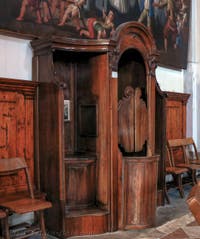
Pius X's confessional In the church of San Martino Vescovo, you can also see the confessional in which Giuseppe Sarto, who became the Cardinal and Patriarch of Venice and then Pope.
Giuseppe Sarto is indeed better known as Pius X., who was Pope from 1894 to 1903.
To see in this tiny island of Burano the small confessional where he confessed the Buranelli for several years is quite touching.
This 16th-century church is open:
- Monday to Saturday from 09:00 to 12:00 and from 15:00 to 18:00
The island of Burano is about 40 minutes by water bus (line 12) from Venice, boarding is done at Fondamenta Nuove in the Sestier of Cannaregio.
Back to Top of Page


